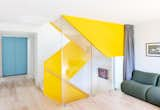The Deep Dive: A Paper Trail
As any issue of Dwell proves, the choice of material or joinery method can transform a good project into a design for the ages. The Deep Dive is a forum where design and building pros can obsess over those details. Here we ask expert colleagues to share the inspiration behind house elements that delight clients—as well as the nitty-gritty information about how they were built.
In the May/June issue feature entitled "My House: This Wildly Colorful Vancouver Home Was Designed Like a Shoe," writer Stacey McLachlan learns the playful roots of the eye-catching family residence that MA+HG Architects designed for Adrian Fluevog and Ali Palmer-Fluevog, stewards of the cult fave Canadian brand John Fluevog Shoes (founded by Adrian’s dad in 1970). To design the jagged house full of cutouts, the Vancouver firm developed concept models using a similar process by which the beloved brand’s designers create footwear. As MA+HG co-principal Harley Grusko told McLachlan, "They use two-dimensional patterns to create three-dimensional objects, so we developed the facades as a singular pattern and folded it to create the home’s shape."
Grusko was the first to propose approaching the project like a footwear designer. With his fellow coprincipal Marianne Amodio and associate architect Adrienne Rademaker, he established a paper template sized and shaped to conform to Adrian and Ali’s desire for net-zero performance and Vancouver’s zoning requirements. The template included an offset gable large enough to accommodate the home’s PV array, and it treated the envelope as a straightforwardly six-sided form to minimize thermal bridging. (Interestingly, Vancouver wouldn’t normally approve an offset gable from a zoning perspective, but the team at MA+HG felt confident that this project would sail through permitting thanks to its net-zero criterion. "In Vancouver we have a great climate initiative that’s really starting to influence form factor and percentage of openings," Amodio says.)
Then it came time to play. As Rademaker recalls, "Harley printed off a few templates and handed some to me and some to Marianne, and we started drawing [fenestration and color blocking] on them and folding them together." The three professionals identified the paper models they found to be most beautiful, and they conveyed that shortlisted group to the homeowners.
The couple in turn suggested tweaks that were both visionary and sensible. Adrian, for example, desired a bigger circular gesture, which led the architects to design the folded cutout on the north side of the street-facing terrace. Meanwhile, the team removed an interior void to maximize guest space in the rear of the second floor. "At the end of the day we really want our projects to work for our clients functionally, programatically, and ergonomically," Amodio says of the homeowners’ feedback.
Further refinement by MA+HG ensued. As Amodio recalls, "You’re constantly thinking about the inside-out. Where’s the bed going to go? How high can that window be off the ground? What is the amount of sunlight we’re getting? How are we going to curtain these windows? Yet even with all those considerations, it was an artful composition."
Amodio admits that MA+HG might never again design a house by folding and cutting out paper templates. But she and Grusko initiate every project with a narrative that infuses their work with meaning: "We were trained at the University of Manitoba to look for concepts and ideas to formulate a design," Amodio says. "Sometimes the formulation will be a meditation on the context or history of the site, or a special material," she adds, "but in a custom home, the best way to find a narrative is to treat the people who will be living there as your muse."
Rademaker adds, "We were riffing off each other to find that intelligent beauty. When Marianne came up with a smart window placement for one bedroom, I played with the window next to it compositionally. Architecture is always about the tension between making the space functional and creating artfulness."
Reflecting on the Fluevog House as it was built, Amodio admits, "Because we use a lot of color and pattern, I’ve heard our work discussed in a kind of dismissive way…but our work always grapples with technical constraints and other guardrails head-on. We always believe that no matter the constraint, it’s our duty to bring creativity to the built environment. Now more than ever, as housing becomes increasingly unaffordable and building codes become more restrictive, championing the qualitative aspects of architecture is important."
Published
Topics
The Deep DiveGet the Pro Newsletter
What’s new in the design world? Stay up to date with our essential dispatches for design professionals.



